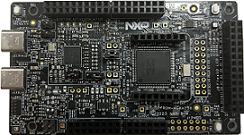NXP FRDM-MCXA156
Overview
FRDM-MCXA156 are compact and scalable development boards for rapid prototyping of MCX A15X MCUs. They offer industry standard headers for easy access to the MCUs I/Os, integrated open-standard serial interfaces, external flash memory and an on-board MCU-Link debugger. MCX N Series are high-performance, low-power microcontrollers with intelligent peripherals and accelerators providing multi-tasking capabilities and performance efficiency.

Hardware
MCX-A156 Arm Cortex-M33 microcontroller running at 96 MHz
1MB dual-bank on chip Flash
128 KB RAM
USB high-speed (Host/Device) with on-chip HS PHY. HS USB Type-C connectors
2x FlexCAN with FD, 2x I3Cs, 2x SAI
On-board MCU-Link debugger with CMSIS-DAP
Arduino Header, FlexIO/LCD Header, SmartDMA/Camera Header, mikroBUS
For more information about the MCX-A156 SoC and FRDM-MCXA156 board, see:
Supported Features
The FRDM-MCXA156 board configuration supports the following hardware features:
Interface |
Controller |
Driver/Component |
|---|---|---|
NVIC |
on-chip |
nested vector interrupt controller |
SYSTICK |
on-chip |
systick |
PINMUX |
on-chip |
pinmux |
GPIO |
on-chip |
gpio |
UART |
on-chip |
serial port-polling; serial port-interrupt |
CLOCK |
on-chip |
clock_control |
FLASH |
on-chip |
soc flash |
Targets available
The default configuration file boards/nxp/frdm_mcxa156/frdm_mcxa156_defconfig
Other hardware features are not currently supported by the port.
Connections and IOs
The MCX-A156 SoC has 5 gpio controllers and has pinmux registers which can be used to configure the functionality of a pin.
Name |
Function |
Usage |
|---|---|---|
PIO0_2 |
UART |
UART RX |
PIO0_3 |
UART |
UART TX |
System Clock
The MCX-A156 SoC is configured to use FRO running at 96MHz as a source for the system clock.
Serial Port
The FRDM-MCXA156 SoC has 5 LPUART interfaces for serial communication. LPUART 0 is configured as UART for the console.
Programming and Debugging
Build and flash applications as usual (see Building an Application and Run an Application for more details).
Configuring a Debug Probe
A debug probe is used for both flashing and debugging the board. This board is configured by default to use the MCU-Link CMSIS-DAP Onboard Debug Probe.
Using LinkServer
Linkserver is the default runner for this board, and supports the factory
default MCU-Link firmware. Follow the instructions in
MCU-Link CMSIS-DAP Onboard Debug Probe to reprogram the default MCU-Link
firmware. This only needs to be done if the default onboard debug circuit
firmware was changed. To put the board in DFU mode to program the firmware,
short jumper JP5.
Using J-Link
There are two options. The onboard debug circuit can be updated with Segger
J-Link firmware by following the instructions in
MCU-Link JLink Onboard Debug Probe.
To be able to program the firmware, you need to put the board in DFU mode
by shortening the jumper JP5.
The second option is to attach a J-Link External Debug Probe to the
10-pin SWD connector (J24) of the board. Additionally, the jumper JP7 must
be shortened.
For both options use the -r jlink option with west to use the jlink runner.
west flash -r jlink
Configuring a Console
Connect a USB cable from your PC to J21, and use the serial terminal of your choice (minicom, putty, etc.) with the following settings:
Speed: 115200
Data: 8 bits
Parity: None
Stop bits: 1
Flashing
Here is an example for the Hello World application.
# From the root of the zephyr repository
west build -b frdm_mcxa156 samples/hello_world
west flash
Open a serial terminal, reset the board (press the RESET button), and you should see the following message in the terminal:
*** Booting Zephyr OS build v3.6.0-4478-ge6c3a42f5f52 ***
Hello World! frdm_mcxa156/mcxa156
Debugging
Here is an example for the Hello World application.
# From the root of the zephyr repository
west build -b frdm_mcxa156/mcxa156 samples/hello_world
west debug
Open a serial terminal, step through the application in your debugger, and you should see the following message in the terminal:
*** Booting Zephyr OS build v3.6.0-4478-ge6c3a42f5f52 ***
Hello World! frdm_mcxa156/mcxa156
